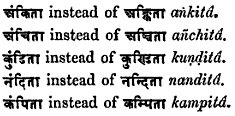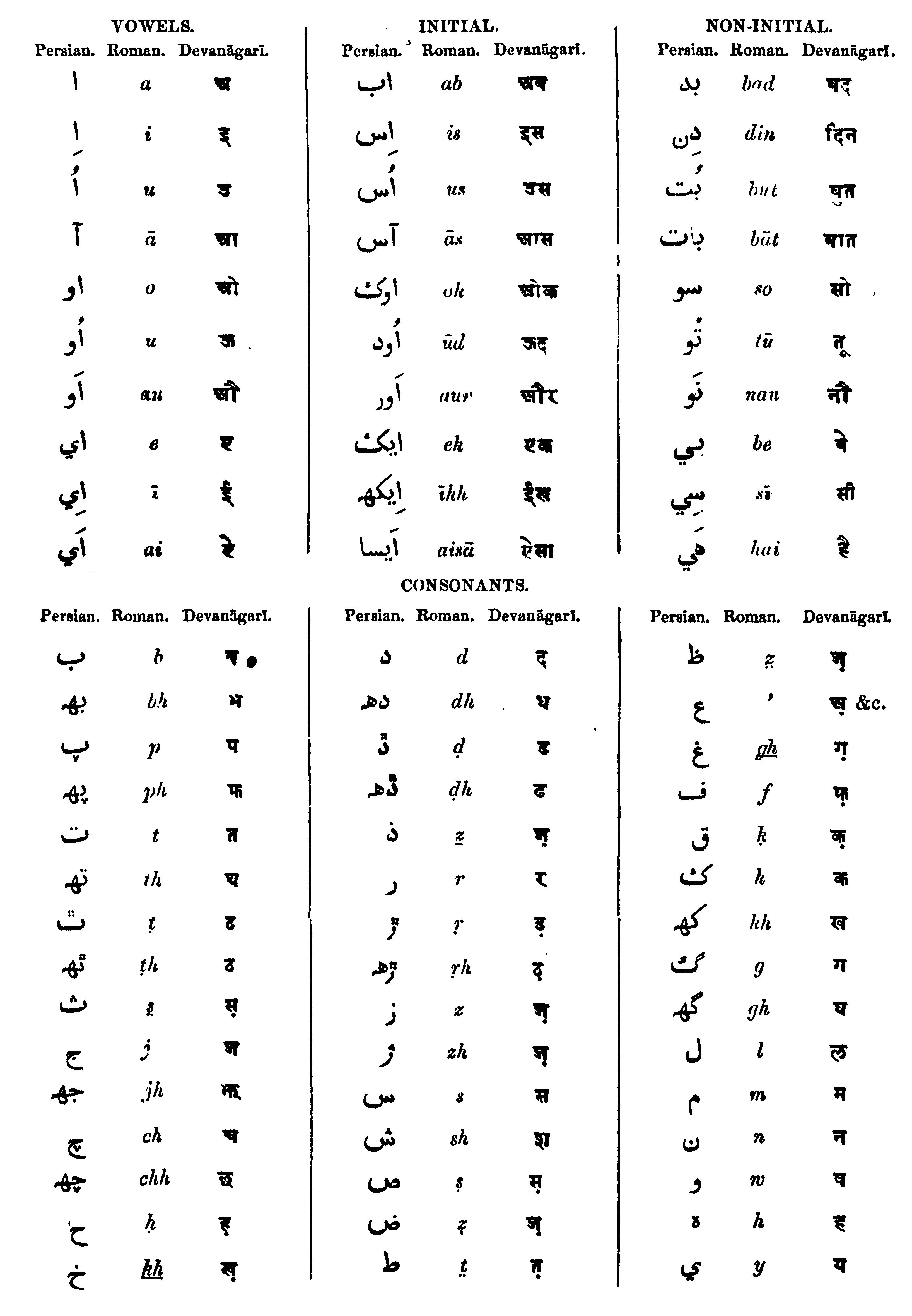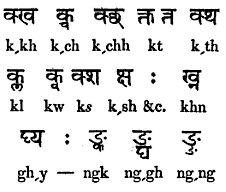Hunterian Transliteration on:
[Wikipedia]
[Google]
[Amazon]
The Hunterian transliteration system is the "national system of
 The original precursor to the Hunterian system was a transliteration method developed by Charles Wilkins, who is sometimes called the "father of
The original precursor to the Hunterian system was a transliteration method developed by Charles Wilkins, who is sometimes called the "father of
 Main Hindustani vowels with their various representations:
Main Hindustani vowels with their various representations:


 In the Hunterian system, implicit schwas are denoted by the transliterated schwa vowel in Devanagari, ''a'' (अ), and excluded as necessary under schwa deletion rules. Aspirations are represented by ''h''. Retroflex graphemes are often represented by a diacritic dot under the Latin consonant that represents the equivalent dental graphemes in proposals (some of which predate even the Hunterian method), though this has not officially been accepted by the Indian government. Halants are indicated by either leaving out a vowel after the transliterated consonant or, in new proposals (not formally approved by the Indian government), with a period after the applicable consonant (e.g. जल्दी – ''jal.di''). Initially, italics were sometimes used to differentiate consonants such as ख ("kh") and ख़ ("''kh''"), but later macrons and diacritics began to be used more extensively.
In the Hunterian system, implicit schwas are denoted by the transliterated schwa vowel in Devanagari, ''a'' (अ), and excluded as necessary under schwa deletion rules. Aspirations are represented by ''h''. Retroflex graphemes are often represented by a diacritic dot under the Latin consonant that represents the equivalent dental graphemes in proposals (some of which predate even the Hunterian method), though this has not officially been accepted by the Indian government. Halants are indicated by either leaving out a vowel after the transliterated consonant or, in new proposals (not formally approved by the Indian government), with a period after the applicable consonant (e.g. जल्दी – ''jal.di''). Initially, italics were sometimes used to differentiate consonants such as ख ("kh") and ख़ ("''kh''"), but later macrons and diacritics began to be used more extensively.
romanization
In linguistics, romanization is the conversion of text from a different writing system to the Latin script, Roman (Latin) script, or a system for doing so. Methods of romanization include transliteration, for representing written text, and tra ...
in India
India, officially the Republic of India, is a country in South Asia. It is the List of countries and dependencies by area, seventh-largest country by area; the List of countries by population (United Nations), most populous country since ...
" and the one officially adopted by the Government of India
The Government of India (ISO 15919, ISO: Bhārata Sarakāra, legally the Union Government or Union of India or the Central Government) is the national authority of the Republic of India, located in South Asia, consisting of States and union t ...
. Hunterian transliteration was sometimes also called the ''Jonesian transliteration system'' because it derived closely from a previous transliteration method developed by William Jones (1746–1794). Upon its establishment, the Sahitya Akademi
The Sahitya Akademi, India's National Academy of Letters, is an organisation dedicated to the promotion of literature in the languages of India. Founded on 12 March 1954, it is supported by, though independent of the Indian government. Its off ...
(India's National Academy of Letters) also adopted the Hunterian method, with additional adaptations, as its standard method of maintaining its bibliography of Indian-language works.
History
 The original precursor to the Hunterian system was a transliteration method developed by Charles Wilkins, who is sometimes called the "father of
The original precursor to the Hunterian system was a transliteration method developed by Charles Wilkins, who is sometimes called the "father of Devanagari
Devanagari ( ; in script: , , ) is an Indic script used in the Indian subcontinent. It is a left-to-right abugida (a type of segmental Writing systems#Segmental systems: alphabets, writing system), based on the ancient ''Brāhmī script, Brā ...
typography" because he was also the creator of the first Devanagari typeface. William Jones, who also founded the Asiatic Society, further developed the transliteration method. It was given a more complete form in the late nineteenth century by William Wilson Hunter, then Surveyor General of India. When it was proposed, it immediately met with opposition from supporters of the phonetic Dowler system, which climaxed in a dramatic showdown in an India Council meeting on 28 May 1872 where the new Hunterian method carried the day. The Hunterian method was inherently simpler and extensible to several Indic scripts because it systematized grapheme
In linguistics, a grapheme is the smallest functional unit of a writing system.
The word ''grapheme'' is derived from Ancient Greek ('write'), and the suffix ''-eme'' by analogy with ''phoneme'' and other emic units. The study of graphemes ...
transliteration, and it came to prevail and gain government and academic acceptance. Opponents of the grapheme transliteration model continued to mount unsuccessful attempts at reversing government policy until the turn of the century, with one critic calling appealing to "the Indian Government to give up the whole attempt at scientific (i.e. Hunterian) transliteration, and decide once and for all in favour of a return to the old phonetic spelling."
Additional languages and adaptations
Over time, the Hunterian method extended in reach to cover several Indic scripts, including Burmese and Tibetan. The Hunterian system was used to establish writing systems that used the Latin alphabet for some Indian languages that were previously not associated with a written script, such as Mizo. In the case of Mizo, the Hunterian-based writing system "has proved hugely successful." Provisions for schwa deletion in Indo-Aryan languages were also made where applicable, e.g. the Hindi कानपुर is transliterated as ''kānpur'' (and not ''kānapura'') but the Sanskrit क्रम is transliterated as ''krama'' (and not ''kram''). The system has undergone some evolution over time. For instance, long vowels were marked with anacute accent
The acute accent (), ,
is a diacritic used in many modern written languages with alphabets based on the Latin alphabet, Latin, Cyrillic script, Cyrillic, and Greek alphabet, Greek scripts. For the most commonly encountered uses of the accen ...
in the original version, but this was later replaced in the 1954 Government of India update with a macron. Thus, जान ('life') was previously romanized as ''ján'' but began to be romanized as ''jān''. Additional diacritics have been proposed for various purposes, such as disambiguating Urdu
Urdu (; , , ) is an Indo-Aryan languages, Indo-Aryan language spoken chiefly in South Asia. It is the Languages of Pakistan, national language and ''lingua franca'' of Pakistan. In India, it is an Eighth Schedule to the Constitution of Indi ...
letters which map to a single Devanagari grapheme (e.g. and which all map to ). Some languages of the region are tonal, such as Mizo and Punjabi, and accent marks over vowels have been repurposed to indicate tone for some of them.
Vowels
 Main Hindustani vowels with their various representations:
Main Hindustani vowels with their various representations:
Consonants


 In the Hunterian system, implicit schwas are denoted by the transliterated schwa vowel in Devanagari, ''a'' (अ), and excluded as necessary under schwa deletion rules. Aspirations are represented by ''h''. Retroflex graphemes are often represented by a diacritic dot under the Latin consonant that represents the equivalent dental graphemes in proposals (some of which predate even the Hunterian method), though this has not officially been accepted by the Indian government. Halants are indicated by either leaving out a vowel after the transliterated consonant or, in new proposals (not formally approved by the Indian government), with a period after the applicable consonant (e.g. जल्दी – ''jal.di''). Initially, italics were sometimes used to differentiate consonants such as ख ("kh") and ख़ ("''kh''"), but later macrons and diacritics began to be used more extensively.
In the Hunterian system, implicit schwas are denoted by the transliterated schwa vowel in Devanagari, ''a'' (अ), and excluded as necessary under schwa deletion rules. Aspirations are represented by ''h''. Retroflex graphemes are often represented by a diacritic dot under the Latin consonant that represents the equivalent dental graphemes in proposals (some of which predate even the Hunterian method), though this has not officially been accepted by the Indian government. Halants are indicated by either leaving out a vowel after the transliterated consonant or, in new proposals (not formally approved by the Indian government), with a period after the applicable consonant (e.g. जल्दी – ''jal.di''). Initially, italics were sometimes used to differentiate consonants such as ख ("kh") and ख़ ("''kh''"), but later macrons and diacritics began to be used more extensively.
Examples
Example: मैं अपने संबंधी से कारख़ाने में मिला और उसने मुझे चाय पिलाई। वह बारिश के कारण फ़सलों को हुए नुक़सान की वजह से चिंतित था। मैंने उसे अपनी ख़बर सुनाई। क्योंकि मुझे निकलना था, इसीलिए कुछ देर बाद मैंने क्षमा माँगी और वहाँ से रवाना हुआ। With diacritics: Without any diacritics: Notes: संबंधी can interchangeably be written in two different ways: संबंधी and सम्बन्धी. चिंतित can also be written as चिंतित and चिन्तित. Example: इस साल ग्रीष्मकालीन वर्षा ज़्यादा होने से अमरूद और बेर की क़िल्लत देखी गई। मज़े की बात यह है कि सेब और ख़ुबानी की क़ीमतें कम हैं क्योंकि उत्तराखंड में गोदाम भरें हैं. With diacritics: Without any diacritics: Notes: उत्तराखंड can interchangeably be written in two different ways: उत्तराखंड and उत्तराखण्ड.Criticism
The Hunterian system has faced criticism over the years for not producing phonetically accurate results and being "unashamedly geared towards an English-language receiver audience." Specifically, the lack of differentiation betweenretroflex
A retroflex () or cacuminal () consonant is a coronal consonant where the tongue has a flat, concave, or even curled shape, and is articulated between the alveolar ridge and the hard palate. They are sometimes referred to as cerebral consona ...
and dental consonants (e.g. द and ड are both represented by ''d'') has come in for repeated criticism and inspired several proposed modifications of Hunterian, including using a diacritic below retroflexes (e.g. making द=''d'' and ड=''ḍ'', which is more readable but requires diacritic printing) or capitalizing them (e.g. making द=''d'' and ड=''D'', which requires no diacritic printing but is less readable because it mixes small and capital letters in words).
See also
* William Wilson Hunter * Devanagari transliteration *ISO 15919
ISO 15919 is an international standard for the romanization of Indic scripts. Published in 2001, it is part of a series of romanization standards by the International Organization for Standardization.
Overview
Relation to other systems
...
* International Alphabet of Sanskrit Transliteration
* Mizo language writing system
Notes
References
{{Reflist Hindustani orthography Romanization of Brahmic Hindi Sanskrit transliteration Writing systems introduced in the 19th century